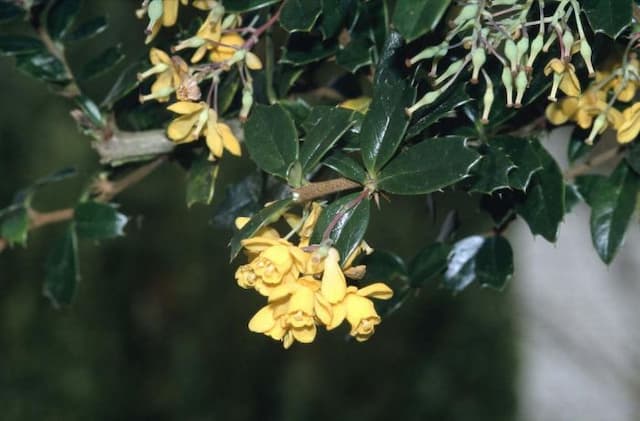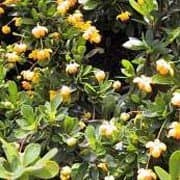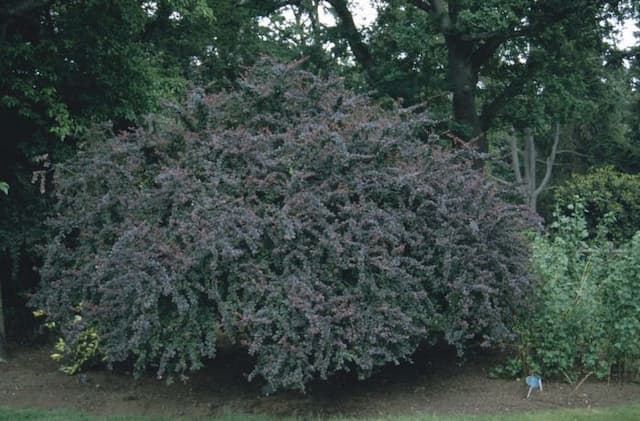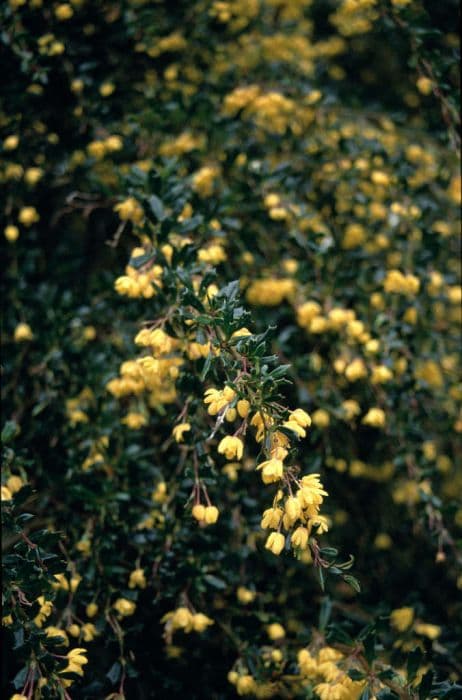Orange Queen Epimedium × warleyense

ABOUT
The plant known commonly as Warley Fairy Wings or Bishop's Hat is adorned with unique and ornate foliage. Its leaves have a complex shape, usually heart-shaped at the base, and can often appear as if they are comprised of spiny-edged leaflets, arrayed in a spoke-like fashion. The leaves boast a noteworthy color transformation throughout the seasons; they emerge with a red or bronze tint in spring, mature into a lush green as the seasons progress, and in fall, they may develop a bronze or reddish flush once again. Warley Fairy Wings is celebrated as well for its delicate flowers that add a fairy-like charm to its appearance. The blossoms, appearing above the foliage on thin, wiry stems, display an intricate structure with four outer petals and a smaller inner set, often resembling a cup-and-saucer. The flowers are typically a warm shade of orange, copper, or yellow, occasionally with contrasting centers, and they create an enchanting display against the green backdrop of the leaves. The plant weaves a carpet-like presence, with the leaves and flowers providing a multi-dimensional texture that showcases both the heartiness and the gracefulness of its character. It gives the garden a touch of whimsy and visual interest as the seasons change, exemplifying traits commonly sought after by gardeners looking for year-round attractiveness.
About this plant
 Names
NamesSynonyms
Warley Fairy Wings, Warley Epimedium, Orange Queen Epimedium
Common names
Epimedium × warleyense.
 Toxicity
ToxicityTo humans
The plant known as Bishop's Hat is not commonly associated with being toxic to humans. There are no widespread reports of poisoning or toxic effects from ingesting any part of the Epimedium × warleyense. However, as with any plant, individuals may have differing sensitivities, and it is always advisable to avoid eating plants that are not known to be edible or that have not been properly identified as safe by an expert.
To pets
Bishop's Hat is not commonly known to be toxic to pets either. There is limited information on the toxicity of Epimedium × warleyense to pets such as dogs and cats, but it is not listed among the plants that are commonly considered poisonous to them. That said, pet owners should always prevent pets from eating ornamental plants as a general safety precaution, since individual pets may have unique sensitivities or allergic reactions.
 Characteristics
CharacteristicsLife cycle
Perennials
Foliage type
Semi-deciduous
Color of leaves
Green
Flower color
Orange
Height
1-2 feet (30-60 cm)
Spread
1-2 feet (30-60 cm)
Plant type
Herb
Hardiness zones
5
Native area
China
Benefits
 General Benefits
General Benefits- Attracts Pollinators: Epimedium × warleyense, commonly known as Bishop's Hat, is known for its ability to attract pollinators like bees and butterflies to the garden.
- Drought Tolerance: Once established, Bishop's Hat exhibits good drought tolerance, making it suitable for xeriscaping or gardens with low water availability.
- Ground Cover: The plant's spreading habit makes it an excellent ground cover option, suppressing weeds and reducing soil erosion.
- Shade Tolerance: Bishop's Hat thrives in partial to full shade, making it an ideal choice for under-plantings in shaded areas or woodland gardens.
- Ornamental Value: The plant boasts attractive, heart-shaped leaves and colorful flowers, enhancing the visual appeal of garden landscapes.
- Low Maintenance: It requires minimal care once established, making it a convenient choice for busy gardeners or those seeking low-maintenance gardening.
- Erosion Control: Its robust root system helps to stabilize soil on slopes or in areas prone to erosion.
- Wildlife Habitat: It provides shelter and habitat for various small animals and beneficial insects within a garden ecosystem.
 Medical Properties
Medical PropertiesThis plant is not used for medical purposes.
 Air-purifying Qualities
Air-purifying QualitiesThis plant is not specifically known for air purifying qualities.
 Other Uses
Other Uses- Epimedium × warleyense, commonly known as Bishop's Hat, can be utilized as a ground cover in shady areas where grass struggles to grow, providing a lush, leafy carpet under trees.
- The plant's colorful leaves can be used in floral arrangements to provide a contrasting backdrop for bright flowers, adding depth and interest to bouquets.
- Bishop's Hat serves as a natural mulch by suppressing weed growth due to its dense foliage when planted closely in garden beds.
- Its robust nature makes it suitable for controlling soil erosion on slopes and banks, where it can establish a firm root system to hold the soil in place.
- Gardeners use the dried seed pods of Bishop's Hat for crafting, as they have an interesting shape that can be incorporated into decorative items such as wreaths and dried arrangements.
- In garden design, the plant's variety of leaf colors through the seasons offers opportunities for creating year-round visual interest in temperate landscapes.
- The plant provides habitat and shelter to small wildlife, particularly beneficial insects that seek refuge among its leaves and flowers.
- Its early spring blooms are valuable for sustaining pollinators like bees when few other nectar sources are available.
- Landscape architects may use Bishop's Hat for green roofing projects in areas with appropriate climates, due to its low maintenance and resilience.
- The plant can be used to delineate pathways or edge garden borders, providing a natural, soft boundary that complements the garden aesthetics.
Interesting Facts
 Feng Shui
Feng ShuiThe plant Bishop's Hat is not used in Feng Shui practice.
 Zodiac Sign Compitability
Zodiac Sign CompitabilityThe plant Bishop's Hat is not used in astrology practice.
 Plant Symbolism
Plant Symbolism- Love and Attraction: Commonly known as the Bishop's Hat, Epimedium × warleyense is often associated with love due to its heart-shaped leaves, suggesting it can symbolize an open heart or readiness for love.
- Sexual prowess: Since Epimedium species are also referred to as "horny goat weed", they carry a connotation of sexual vitality and are believed to enhance libido, representing virility or sexual prowess.
- Fertility: With its lush growth and ability to spread, the Bishop's Hat can symbolize fertility and abundance.
- Longevity: Given that Epimedium is a long-lived perennial that thrives under diverse conditions, it can symbolize longevity and resilience.
- Protection: The Bishop's Hat’s ability to grow in challenging environments also gives it the symbolic meaning of protection and overcoming obstacles.
 Water
WaterBishop's hat should be watered thoroughly once the top inch of soil feels dry, typically about once a week, but this can vary with temperature and humidity levels. During the growing season in spring and summer, they may need more frequent watering, while in the winter, you should reduce the frequency. On average, you might use up to half a gallon for a medium-sized plant each time you water. Ensure that the water penetrates the soil deeply to encourage root growth, but avoid waterlogging as this can lead to root rot.
 Light
LightBishop's hat prefers a location with partial shade or filtered sunlight. It thrives best when it is protected from the harsh afternoon sun, making a spot with morning sun and afternoon shade ideal. This plant can also grow under full shade conditions, but flowering may be less prolific. It's important to avoid placing it in direct, hot sunlight as this can scorch the leaves and stress the plant.
 Temperature
TemperatureBishop's hat grows well in a range of temperature conditions and can survive temperature swings between 50 and 80 degrees Fahrenheit. However, it thrives best at moderate temperatures between 60 and 70 degrees Fahrenheit. It can tolerate a drop in temperature down to about 20 degrees Fahrenheit, but prolonged exposure to temperatures below freezing can damage the plant.
 Pruning
PruningPruning Bishop's hat should occur in late winter or early spring, before new growth begins. The purpose of pruning is to remove any dead or damaged foliage from the previous year, and to maintain the desired shape and size of the plant. It's typically necessary once a year, at which time you can cut back the older leaves to make way for fresh growth. Pruning also helps to rejuvenate the plant and encourages a more robust display of flowers.
 Cleaning
CleaningAs needed
 Soil
SoilBishop's hat thrives in a soil mix consisting of equal parts garden soil, compost, and peat moss or leaf mold, maintaining a slightly acidic to neutral pH of 5.5 to 7. Well-draining soil is essential to prevent root rot.
 Repotting
RepottingBishop's hat rarely needs repotting; it should be divided and repotted every 3 to 4 years in the spring to rejuvenate and prevent overcrowding.
 Humidity & Misting
Humidity & MistingBishop's hat prefers moderate humidity levels but is quite adaptable and tolerant of the average humidity found in most garden environments.
 Suitable locations
Suitable locationsIndoor
Place Bishop's hat in bright, indirect light and ensure moist soil.
Outdoor
Plant in partial shade, and mulch to retain soil moisture.
Hardiness zone
5-9 USDA
 Life cycle
Life cycleEpimedium × warleyense, commonly known as Warley Fairy Wings, begins its life cycle as a seed, which after a period of dormancy, germinates in the spring when temperatures warm up. The seedling emerges and develops into a juvenile plant with characteristic heart-shaped leaves, which undergoes a period of vegetative growth. As the plant matures, it forms a clump with a rhizomatous root system which aids in its perennial nature, spreading slowly to colonize the surrounding area. Flowering typically occurs in late spring, displaying the distinctive orange and yellow blooms which attract pollinators. After pollination, seeds are produced and dispersed, continuing the life cycle. During winter, the aerial parts of the plant may die back, with the rhizomes surviving underground to send up new growth the following spring.
 Propogation
PropogationPropogation time
Spring to early summer
The most popular method of propagation for Epimedium × warleyense, commonly known as the Warley Fairy Wings or Orange Queen, is by division. This is ideally done in the late summer to early fall after the flowering period has ended. To propagate by division, carefully dig up an established clump of Warley Fairy Wings, ensuring that you maintain a good amount of root structure with each section. Using a sharp knife or spade, divide the clump into smaller sections, each with several growth points. Then, replant the divisions at the same depth they were originally growing, spacing them about 12 inches (approximately 30 centimeters) apart to allow room for growth. Ensure the newly planted divisions are well-watered and continue to provide moisture until they are established. Division allows the plant to rejuvenate and can lead to more vigorous growth in the next blooming season.









